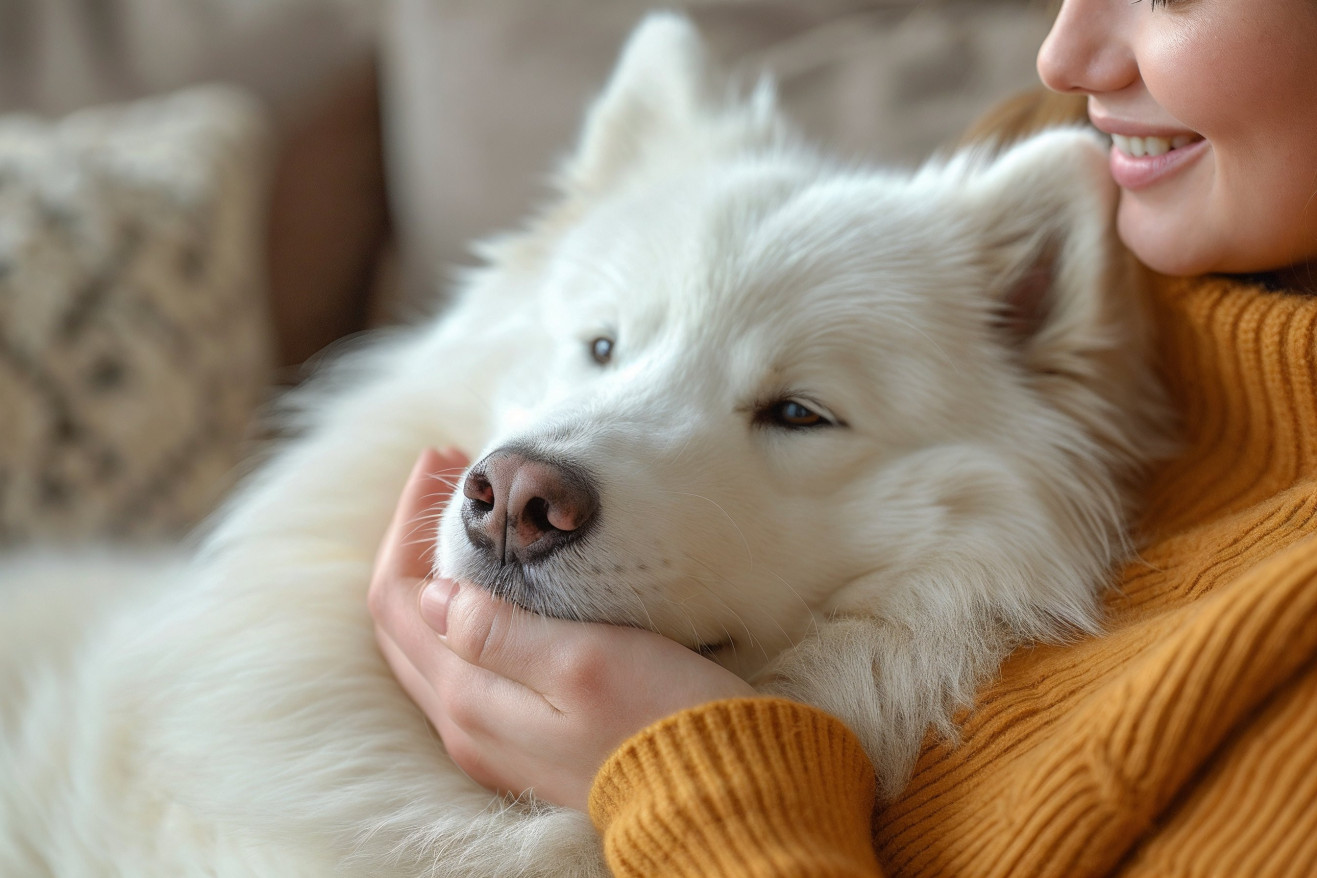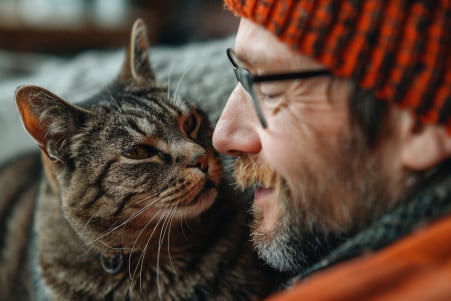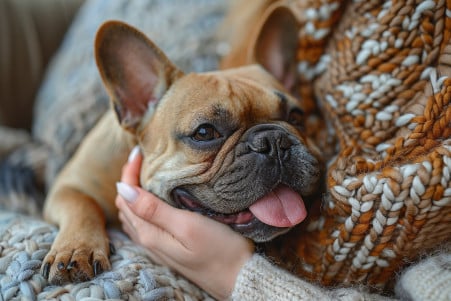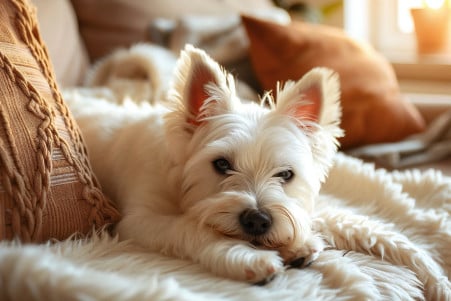Why Does My Dog Nibble on Me? Decoding Canine Affection and Stress Signals
7 February 2024 • Updated 7 February 2024

When your dog nibbles on you, they may be trying to communicate something with you. In general, dogs nibble on people for a few different reasons: to show affection, to play, to relieve stress, or to get attention. Nibbling is a form of gentle mouthing that is a normal, social behavior in dogs and is different from aggressive biting.
In this deep dive into dog behavior, we reference veterinarians, animal behaviorists, and ethological studies to learn more. Our investigation takes us through the many reasons dogs nibble, from expressions of love to signs of stress.
By looking at the emotional and physiological sides of the equation, we can put together the developmental and communicative puzzle pieces in dogs to give you a full picture of what your dog is trying to tell you when they nibble on you.
Why does my dog nibble on me?
What the Nibbling May Mean
When your dog nibbles on you, it can mean a number of things. It can be a sign of affection or a sign of stress. In other words, it can be a way for your dog to communicate how it’s feeling.
According to Top Dog Tips, mouthing, which is closely related to nibbling, can be a sign of a dog’s curiosity or a desire to play, but it can also be a sign of stress or excitement.
The idea of ‘mouthiness’ is often associated with nibbling and is a sign of your dog’s emotional state. Roman’s Holistic Dog Training explains that many behavioral issues, including excessive mouthing or nibbling, are a result of emotional neglect.
Dogs are highly emotional animals and their emotional intelligence is often compared to that of a human toddler. As a result, their behaviors, including nibbling, can be a sign that they need more emotional support or a way to manage their own stress.
There are other factors that can also play a role in your dog’s nibbling. Canine Body Balance explains that it’s important to understand your dog’s body language and emotional state so that you can better meet their needs.
It’s also important to learn how to manage stress-related nibbling, which can be done by ensuring that your dog has a supportive environment, including enough exercise and environmental enrichment. In addition to understanding the emotional causes of nibbling, it’s also important to understand the physical causes of nibbling.
The Biology of Your Dog’s Nibbling
Looking at the sensory and neurological components of your dog’s behavior can help explain why dogs nibble. The American Kennel Club notes that sensory stimulation is involved in puppies’ bite inhibition, or their ability to control the pressure of their bite. This is an important developmental milestone that helps adult dogs safely interact with people and other animals.
Sensory exploration of different textures and tastes can also lead to nibbling. Dogs tend to explore their senses as they grow, and this exploration often continues into adulthood, especially if they find a texture or taste that they particularly enjoy.
In addition, the physical characteristics of certain breeds may make them more likely to nibble. Karen B. London and Max Belenitsky point out that a dog’s use of its mouth is influenced by early socialization and bite inhibition, which can vary between breeds with different herding, hunting, or retrieving backgrounds.
While these biological factors are important to keep in mind, it’s also important to remember that a dog’s nibbling can be a sign of how it communicates and interacts with the world.
Nibbling and Canine Communication
Far from being a simple behavioral quirk, nibbling is a complex part of canine communication that adds depth to the way dogs communicate with humans and other dogs. A study in the journal PMC found that dogs use a complex combination of visual, acoustic, and olfactory signals to communicate.
Nibbling is closely related to social behaviors like grooming, care, or play, all of which are friendly behaviors. As a result, dogs use nibbling to communicate a wide range of feelings and intentions, from love to interest, showing just how complex and nuanced their communication can be.
In addition, different dog breeds may bring their own unique styles of nibbling to the table.
The AKC explains that differences in breed body language can impact how dogs communicate.
For example, a playful nibble from a herding dog may be a part of their communication style, while a toy breed may be more likely to nibble as a sign of affection. Understanding these behaviors as part of a dog’s communication style is important for meeting their needs and building a strong relationship between dogs and people.
By understanding the nuances and differences in how different breeds communicate through nibbling, we can make sure we respond in ways that support positive communication and a healthy relationship.
Cultivating Healthy Habits: How to Stop Dog Biting
Stopping dog biting requires patience and understanding. When your dog bites too hard, give them a gentle signal that they’ve hurt you; a simple “ouch” and a break in play can let them know that they’ve applied too much pressure, according to the ASPCA. It’s important to be consistent—make sure that everyone in your household is on the same page about how to interact with the dog.
To redirect your dog’s biting, replace your hands with chew toys or bones, according to the ASPCA. These should be interesting enough to hold your dog’s attention and satisfy their need to bite. Playing games that don’t involve physical contact, like fetch or tug-of-war, can also help you manage your dog’s biting.
Positive reinforcement is an important part of teaching your dog how to behave. By praising and rewarding your dog when they play gently and bite appropriately, you can help ensure that they continue to behave in this way. It’s important to note that you’re not trying to stop the behavior altogether, just make sure that it’s gentle.
If your dog’s biting becomes too much or if it’s accompanied by aggression, it could be a sign of a bigger problem. If your dog is biting hard and often, especially when you’re not playing, it could be a sign that you need professional help, according to the Whole Dog Journal.
Make sure to get a professional’s help so that you can address your dog’s behavior in a way that’s safe and healthy for both your dog and your family.
Understanding Dog Nibbling: The Takeaway
In wrapping up our deep dive into the world of dog nibbling, we’ve learned that these seemingly simple acts are actually quite complex and can be driven by a number of emotional and physical factors.
Dogs may nibble to show affection, to engage in play, to relieve stress, or to get attention. Nibbling can also be a sign of stress, triggered by emotional factors like anxiety and excitement, and driven by sensory and neurological factors.
It’s important to understand nibbling in the context of dog communication. Whether it’s a social interaction like grooming or a play bow, knowing the motivation behind a dog’s nibble can help you better understand the nuanced ways that dogs communicate. In addition, the breed-specific factors that experts have pointed out show how different dogs’ nibbling behaviors can be.
By managing nibbling in a way that uses positive reinforcement and offers alternative behaviors, like chew toys, we can make sure that nibbling continues to be a positive part of our relationships with our dogs. This kind of positive management of nibbling, beyond the cute quirks, is a sign of the deep connection we have with dogs, which is based on understanding and respect.


